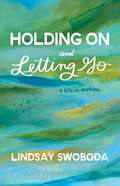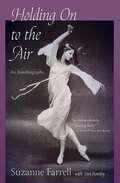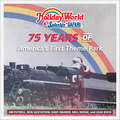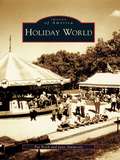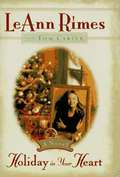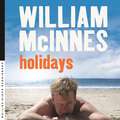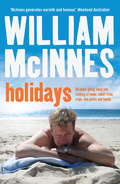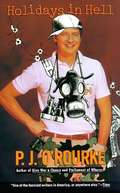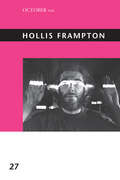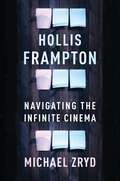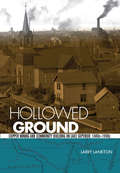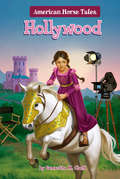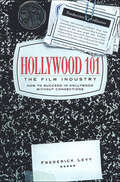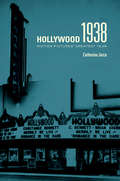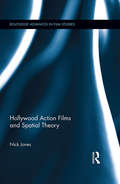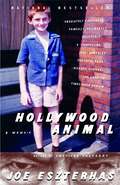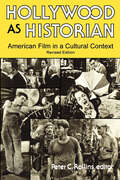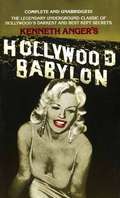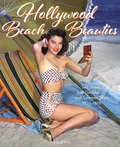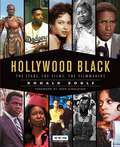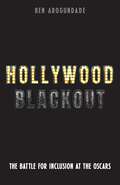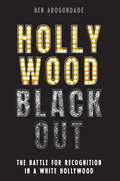- Table View
- List View
Holding On and Letting Go: A Life in Motion
by Lindsay Swoboda&“... explores the ache of holding on—to dreams, identity, and relationships ... the moments of joy, unexpected community, rediscovered passion ... Her storytelling is lyrical, grounded, and profoundly human ...&”—Corie Weathers, LPC, author, clinician, military spouseWhen dancer Lindsay Swoboda marries a Marine, her dream of following her passion for performing collides with the realities of their military life: back-to-back overseas moves, navigating pregnancy during deployment, and creating new support systems again and again.As their growing family moves around the globe, Lindsay finds both tension and beauty in each new beginning. She creates a dance program in Korea. Becomes a mother in Hawaii. Morocco offers healing for her marriage after multiple deployments. In Ecuador, a fire, riots, and a high-risk pregnancy remind her there is uncertainty even in what appears to be a peace-filled chapter. Looking forward to being closer to family after nearly a decade away, the Swobodas nestle into Virginia just in time for the COVID-19 pandemic. Seeking new ways to cope with constant change and challenge, Lindsay writes her way through loneliness, self-doubt, and anxiety, and shares the burden and brilliance of each season with a community of friends. In her memoir Holding On and Letting Go: A Life in Motion, Lindsay unfolds her military spouse journey with lyrical storytelling and sensory imagery, encouraging readers to champion both big and small victories, make space for grief and goodness, and find the courage to persevere. Cover art painting by military spouse Lindsay Wilkins.
Holding On to the Air: An Autobiography
by Suzanne FarrellSuzanne Farrell, world-renowned ballerina, was one of George Balanchine's most celebrated muses and remains a legendary figure in the ballet world. This memoir, first published in 1990 and reissued with a new preface by the author, recounts Farrell's transformation from a young girl in Ohio dreaming of greatness to the realization of that dream on stages all over the world. Central to this transformation was her relationship with George Balanchine, who invited her to join the New York City Ballet in the fall of 1961 and was in turn inspired by her unique combination of musical, physical, and dramatic gifts. He created masterpieces for her in which the limits of ballet technique were expanded to a degree not seen before. By the time she retired from the stage in 1989, Farrell had achieved a career that is without precedent in the history of ballet. One third of her repertory of more than 100 ballets were composed expressly for her by such notable choreographers as Balanchine, Jerome Robbins, and Maurice Bejart. Farrell recalls professional and personal attachments and their attendant controversies with a down-to-earth frankness and common sense that complements the glories and mysteries of her artistic achievement.
Holiday World & Splashin' Safari: 75 Years of America's First Theme Park
by Jim Futrell Dave Hahner Ron Gustafson Nell HedgeAmerica's first theme park, Holiday World & Splashin' Safari, is one of the largest family-owned and -operated independent parks in the United States, and its success is no accident. From moving Interstate 64 closer to the small town to introducing free unlimited soft drinks, four generations of the Koch family have amplified the legacy of this iconic Indiana attraction.Holiday World & Splashin' Safari celebrates the history of the Koch family and Santa Jim Yellig; the origins of Santa Claus, Indiana; and the early years of Santa Claus Land. The story continues with the expansion from Santa Claus Land to Holiday World, the addition of the park's famous trio of top-ranked wooden roller coasters, and the development of Splashin' Safari Water Park, ranked one of the top water parks in the country. For three-quarters of a century, the Koch family has launched the park into worldwide renown and national recognition. Featuring over 100 color illustrations, Holiday World & Splashin' Safari relives this joyous past while looking forward to the thrills fans can expect in the next 75 years.
Holiday World (Images of America)
by Pat Koch Jane AmmesonLouis J. Koch had a dream--one of family, fun, and Christmastime year-round. And so he created Santa Claus Land, the nation's first theme park, in Santa Claus, located in the gentle rolling hills of southern Indiana. Now, six decades later, Koch's legacy lives on at Holiday World and Splashin' Safari. Still owned and operated by the Koch family, Holiday World and Splashin' Safari are consistently voted the friendliest and cleanest parks in the country, and their wooden roller coasters are rated in the top ten list among coaster enthusiasts. The Koch family members treat visitors to the park as family and welcome everyone into what has become a true extension of their home.
Holiday in Your Heart
by Tom Carter Leann RimesMany girls dream of becoming princesses, but for the heroine of Holiday in Your Heart, nothing could be better than singing at the Grand Ole Opry. Teenaged singing sensation Anna Lee has realized her dream of performing a holiday concert on the fabled stage. Yet her happiness is clouded by thoughts of her grandmother, stricken with a serious illness back in her native Mississippi and unable to see her beloved granddaughter triumph at this special time of year. It takes the lessons of an older country singer, a musical legend now past her prime, to show the young woman that if you carry a holiday in your heart all year round, you'll always know which things really matter, which songs are the ones you have to sing. LeAnn Rimes's legions of fans will find Holiday in Your Heart a tale as heartrending as the finest country ballad. Born in 1982 in Pearl, Mississippi, LEANN RIMES now lives at home with her parents in Dallas, Texas. Her phenomenal rise in the music industry began with her debut album, Blue, which almost immediately went to Billboard Top 10, making Rimes the youngest country singer ever to debut that high. She is the only country artist ever to have won a Grammy for Best New Artist; she is also the only artist (country or otherwise) to have had a Top 10 hit on the Billboard charts in the country and pop categories at the same time. Tom CARTER has cowritten more bestselling celebrity memoirs than anyone else in the past decade, having collaborated with George Jones, Reba McEntire, Ralph Emery, Glen Campbell, and Ronnie Milsap. Before he worked with Nashville's royalty, he was a writer for People and Time magazines. He lives in Nashville.
Holidays
by William McInnesWritten and read by bestselling Australian author and much loved actor, William McInnes, this is a story about our love affair with holidays.It's about going away and staying at home. It's about the relaxing times you had as a kid, escapes you have with your children and the stories you hear from your friends.It can be about a romantic sunset, the spare seat at breakfast being taken by an attractive stranger, a miraculous airline upgrade - or missing bags, unfortunate rashes and wrong turns that lead to places you definitely did not intend to go.But most of all it's about being in your backyard in an above-ground pool, floating in circles, staring at the clouds as you go round and round, and knowing as you float that life is sweet because you're on holidays.PRAISE for William McInnes' books:'skilfully constructed...insightful, understated and very funny' Sydney Morning Herald on THE LAUGHING CLOWNS'The Making of Modern Australia is a ripper' The Canberra Times'William McInnes compels with the sheer delightfulness of his memoir, and with his fine ability to spin a damn funny yarn' Sunday Telegraph on A MAN'S GOT TO HAVE A HOBBY'funny and clever' Daily Telegraph on THAT'D BE RIGHT'A big-hearted novel with character' Sunday Telegraph on CRICKET KINGS
Holidays
by William McinnesFrom bestselling author William McInnes, a book about the languid, unending holidays of summer; it's about going away and staying at home, about sunburn, seagulls, family and friends.Remember those long, languid holidays when the only decisions to be made were what to pack in the Esky and who should get the front seat on the drive to the beach?Let William McInnes reignite your nostalgia for holidays past, and give you a taste of the boundless opportunities that await in holidays to come in this book about our love affair with life away from the everyday.This book will take you back to the holidays you had as a kid and remind you of the ones you've had with your own family or friends or even the ones where you've flown solo.Holidays are the runway to possibilities - a romantic sunset, the spare seat at breakfast being taken by an attractive stranger, a miraculous airline upgrade - or missing bags, unfortunate rashes and wrong turns that lead to places you definitely did not intend to go. Whether you are away from home and somewhere exotic or just in your own backyard on a lilo in an above-ground pool, whatever happens, you know that life is sweet because you're on HOLIDAYS.Whatever kind of holiday you've got planned, make sure you pack this warm and funny celebration of Australia's favourite national pastime.PRAISE for William McInnes's previous books: 'skilfully constructed...insightful, understated and very funny' Sydney Morning Herald on The Laughing Clowns'The Making of Modern Australia is a ripper' The Canberra Times'William McInnes compels with the sheer delightfulness of his memoir, and with his fine ability to spin a damn funny yarn' Sunday Telegraph on A Man's Got To Have a Hobby'funny and clever' Daily Telegraph on That'd Be Right'A big-hearted novel with character' Sunday Telegraph on Cricket Kings
Holidays On Ice
by David SedarisHOLIDAYS ON ICE collects six of David Sedaris's most profound Christmas stories into one slender volume, perfect for use as a last-minute coaster or ice scraper. This drinking man's companion can be enjoyed by the warmth of a raging fire, the glow of a brilliantly decorated tree, or even in the backseat of a van or police car.
Holidays in Hell
by P. J. O'RourkeThe author travels to hellholes around the globe, looking for trouble, the truth, and a good time.
Hollis Frampton (October Files #26)
by Michael ZrydThe first collection of critical writing on the work of experimental filmmaker Hollis Frampton.Hollis Frampton (1936–1984) was one of the most important experimental filmmakers and theorists of his time, and in his navigation of artistic media and discourses, he anticipated the multimedia boundary blurring of today&’s visual culture. Indeed, his photography continues to be exhibited, and a digital edition of his films was issued by the Criterion Collection. This book offers the first collection of critical writings on Frampton&’s work. It complements On the Camera Arts and Consecutive Matter, published in the MIT Press&’s Writing Art series, which collected Frampton&’s own writings. October was as central to Frampton as he was to it. He was both a frequent contributor—appearing in the first issue in 1976—and a frequent subject of contributions by others. Some of these important and incisive writings on Frampton&’s work are reprinted here. The essays collected in this volume consider Frampton&’s photographic practice, which continued even after he turned to film; survey his film work from the 1960s to the late 1970s; and explore Frampton&’s grounding in poetics and language. Two essays by the late Annette Michelson, one of the twentieth century&’s most influential writers on experimental film, place Frampton in relation to film and art history. ContributorsGeorge Derk, Ken Eisenstein, Hollis Frampton, Peter Gidal, Barry Goldensohn, Brian Henderson, Bruce Jenkins, Annette Michelson, Christopher Phillips, Melissa Ragona, Allen S. Weiss, Federico Windhausen, Lisa Zaher, Michael Zryd
Hollis Frampton: Navigating the Infinite Cinema (Film and Culture Series)
by Michael ZrydHollis Frampton was an American filmmaker, photographer, and theorist who bridged the experimental film and contemporary art worlds in the 1960s and 1970s. Best known for avant-garde films including Zorns Lemma (1970) and (nostalgia) (1971), Frampton spent his later years working on the unfinished epic Magellan, a monumental cycle that used the metaphor of Ferdinand Magellan’s circumnavigation of the world to rethink the natures and meanings of history, modernity, and cinema. Frampton’s career was cut short by cancer at age 48, with his vast ambitions for the project left incomplete.This book is a groundbreaking and comprehensive account of this remarkable figure’s work in its totality, from Frampton’s earliest films through Magellan. Michael Zryd explores the connections linking Frampton’s art and thought to other media forms, histories, and cultural frameworks. He foregrounds Frampton’s notion of the “infinite cinema,” which redefined the parameters of the medium to encompass all forms of moving image and sound media across the past and future of cinematic possibility. Zryd analyzes Frampton’s ambivalent relationship with modernism and the Enlightenment, showing how the artist navigated between attraction to radical artistic investigation and awareness of this tradition’s implication in colonialism and other oppressive power structures. Shedding new light on Frampton’s project of exploring and critiquing how cinema attempts to capture and understand the world, this book also considers his significance for contemporary art.
Hollowed Ground: Copper Mining and Community Building on Lake Superior, 1840s-1990s
by Larry LanktonDetails a century and a half of copper mining along Upper Michigan's Keweenaw Peninsula, from the arrival of the first incorporated mines in the 1840s until the closing of the last mine in the mid-1990s.
Hollywood #2 (American Horse Tales #2)
by Samantha M. ClarkSet in modern-day California, this American Horse Tale is the story of a young girl who, along with her family's horse, is destined for the big screen.Juniper is a young girl who dreams of making it big in the movies along with her horse, Able. In particular, Juniper is obsessed with getting Able onto her favorite television show, Castle MacAvoy, and will do anything, even slay dragons, to make that happen. Hollywood is part of a series of books written by several authors highlighting the unique relationships between young girls and their horses.
Hollywood 101: The Film Industry
by Frederick LevyLooking for a career in the film business? Look no further.Making it in Hollywood is possible. But only if you have a workable strategy. When author Frederick Levy launched his own fledgling career, he didnt' know a soul in the business. But that didn't stop him and it doesn't have to stop you. Hollywood 101 is a complete game plan for getting your foot in the door of the film industry. With fascinating inside stories and advice from key players, it takes you step-by-step up the ladder of success. Whether you aspire to be a producer, director, writer, talent agent, and any other behind-the-camera professional, this is the one book you need to turn your "reel" dreams into reality!
Hollywood 1938
by Catherine JurcaIn Hollywood 1938, Catherine Jurca brings to light a tumultuous year of crisis that has been neglected in histories of the studio era. With attendance in decline, negative publicity about stars that were "poison at the box office," and a spate of bad films, industry executives decided that the public was fed up with the movies. Jurca describes their desperate attempt to win back audiences by launching Motion Pictures' Greatest Year, a massive, and unsuccessful, public relations campaign conducted in theaters and newspapers across North America. Drawing on the records of studio personnel, independent exhibitors, moviegoers, and the motion pictures themselves, she analyzes what was wrong--and right--with Hollywood at the end of a heralded decade, and how the industry's troubles changed the making and marketing of films in 1938 and beyond.
Hollywood Action Films and Spatial Theory (Routledge Advances in Film Studies)
by Nick JonesThis book applies the discourse of the so-called ‘spatial turn’ to popular contemporary cinema, in particular the action sequences of twenty-first century Hollywood productions. Tackling a variety of spatial imaginations (contemporary iconic architecture; globalisation and non-places; phenomenological knowledge of place; consumerist spaces of commodity purchase; cyberspace), the diverse case studies not only detail the range of ways in which action sequences represent the challenge of surviving and acting in contemporary space, but also reveal the consistent qualities of spatial appropriation and spatial manipulation that define the form. Jones argues that action sequences dramatise the restrictions and possibilities of space, offering examples of radical spatial praxis through their depictions of spatial engagement, struggle and eventual transcendence.
Hollywood Animal: A Memoir
by Joe EszterhasHe spent his earliest years in post WWII-refugee camps. He came to America and grew up in Cleveland--stealing cars, rolling drunks, battling priests, nearly going to jail. He became the screenwriter of the worldwide hits Basic Instinct, Jagged Edge, and Flashdance. He also wrote the legendary disasters Showgirls and Jade. The rebellion never ended, even as his films went on to gross more than a billion dollars at the box office and he became the most famous--or infamous--screenwriter in Hollywood. Joe Eszterhas is a complex and paradoxical figure: part outlaw and outsider combined with equal parts romantic and moralist. More than one person has called him "the devil. " He has been referred to as "the most reviled man in America. " But Time asked, "If Shakespeare were alive today, would his name be Joe Eszterhas?" and he was the first screenwriter picked as one of the movie industry's 100 Most Powerful People. Although he is often accused of sexism and misogyny, his wife is his best friend and equal partner. Considered an apostle of sex and violence, he is a churchgoer who believes in the power of prayer. For many years the ultimate symbol of Hollywood excess, he has moved his family to Ohio and immersed himself in the midwestern lifestyle he so values. Controversial, fearless, extremely talented, and totally unpredictable, the author of the best-selling American Rhapsody and National Book Award nominee Charlie Simpson's Apocalypse has surprised us yet again: he has written a memoir like no other. On one level, Hollywood Animal is a shocking and often devastating look inside the movie business. It intimately explores the concept of fame and gives us a never-before-seen look at the famous. Eszterhas reveals the fights, the deals, the extortions, the backstabbing, and the sex, drugs, and rock'n'roll world that is Hollywood. But there are many more levels to this extraordinary work. It is the story of a street kid who survives a life filled with obstacles and pain . . . a chronicle of a love affair that is sensual, glorious, and unending . . . an excruciatingly detailed look at a man facing down the greatest enemy he's ever fought: the cancer inside him . . . and perhaps most important, Hollywood Animal is the heartbreaking story of a father and son that defines the concepts of love and betrayal. This is a book that will shock you and make you laugh, anger you and move you to tears. It is pure Joe Eszterhas--a raw, spine-chilling celebration of the human spirit.
Hollywood As Historian: American Film in a Cultural Context
by Peter C. Rollins“A commendably comprehensive analysis of the issue of Hollywood’s ability to shape our minds . . . invigorating reading.” ?BooklistFilm has exerted a pervasive influence on the American mind, and in eras of economic instability and international conflict, the industry has not hesitated to use motion pictures for propaganda purposes. During less troubled times, citizens’ ability to deal with political and social issues may be enhanced or thwarted by images absorbed in theaters. Tracking the interaction of Americans with important movie productions, this book considers such topics as racial and sexual stereotyping; censorship of films; comedy as a tool for social criticism; the influence of “great men” and their screen images; and the use of film to interpret history. Hollywood As Historian benefits from a variety of approaches. Literary and historical influences are carefully related to The Birth of a Nation and Apocalypse Now, two highly tendentious epics of war and cultural change. How political beliefs of filmmakers affected cinematic styles is illuminated in a short survey of documentary films made during the Great Depression. Historical distance has helped analysts decode messages unintended by filmmakers in the study of The Snake Pit and Dr. Strangelove. Hollywood As Historian offers a versatile, thought-provoking text for students of popular culture, American studies, film history, or film as history. Films considered include: The Birth of a Nation (1915), The Plow that Broke the Plains (1936), The River (1937), March of Time (1935-1953), City Lights (1931), Modern Times (1936), The Great Dictator (1940), The Grapes of Wrath (1940), Native Land (1942), Wilson (1944), The Negro Soldier (1944), The Snake Pit (1948), On the Waterfront (1954), Dr. Strangelove (1964), Who’s Afraid of Virginia Woolf? (1966), and Apocalypse Now (1979).“Recommended reading for anyone concerned with the influence of popular culture on the public perception of history.” ?American Journalism
Hollywood Babylon: The Legendary Underground Classic of Hollywood's Darkest and Best Kept Secrets
by Kenneth AngerWHITE ELEPHANTS--the God of Hollywood wanted white elephants, and white elephants he got--eight of 'em, plaster mammoths perched on mega-mushroom pedestals, lording it over the colossal court of Belshazzar, the pasteboard Babylon built beside the dusty tin-lizzie trail called Sunset Boulevard.
Hollywood Be Thy Name: The Warner Brothers Story
by Cass W. Sperling Cork Millner Jack WarnerThe Warner Brothers Story: How Harry, Jack, Albert, and Sam Warner immigrated to fabulous wealth, Hollywood riches by founding the Warner Brothers Studio.
Hollywood Beach Beauties: Sea Sirens, Sun Goddesses, and Summer Style 1930-1970
by David WillsA glamorous and nostalgic celebration of the summer through stunning retro photographs of Hollywood beautiesThe author of the acclaimed photo compilations Vegas Gold, Hollywood in Kodachrome, Marilyn Monroe: Metamorphosis, and Audrey: The 60s, now presents a glamorous and nostalgic celebration of summer at the beach, captured in 150 stunning vintage photographs featuring beloved female celebrities, models, and starlets from the 1930s through the 1970s.Renowned independent curator and photographic preservationist David Wills commemorates the allure and joy of the sun, the sand, the ocean, and the fashions of endless summer with this sizzling collection. Hollywood Beach Beauties includes more than one-hundred vibrant color images of some of Hollywood’s most timeless stars lounging and playing at one of the most iconic settings: the beach.Hollywood Beach Beauties highlights the sexy, carefree attitude of the summer, the elegant seaside couture, and the enchanting and alluring beauty of the female form. Included here are candid and stylish photographs featuring stars of yesterday such as Elizabeth Taylor, Rita Hayworth, Audrey Hepburn, Marilyn Monroe, Brigitte Bardot, Sharon Tate, Raquel Welch, Sophia Loren, Dorothy Dandridge, and Nancy Sinatra.A treasure trove for classic movie mavens, vintage photography enthusiasts, and pop culture aficionados, this stunning theme-driven compendium taps into nostalgia for the joys of summer and captures the dazzling beauty of the seaside and some of the most stylish stars of the big screen in a fresh, unique, and captivating way.
Hollywood Black: The Stars, the Films, the Filmmakers (Turner Classic Movies)
by Donald BogleThe films, the stars, the filmmakers-all get their due in Hollywood Black, a sweeping overview of blacks in film from the silent era through Black Panther, with striking photos and an engrossing history by award-winning author Donald Bogle.The story opens in the silent film era, when white actors in blackface often played black characters, but also saw the rise of independent African American filmmakers, including the remarkable Oscar Micheaux. It follows the changes in the film industry with the arrival of sound motion pictures and the Great Depression, when black performers such as Stepin Fetchit and Bill "Bojangles" Robinson began finding a place in Hollywood. More often than not, they were saddled with rigidly stereotyped roles, but some gifted performers, most notably Hattie McDaniel in Gone With the Wind (1939), were able to turn in significant performances.In the coming decades, more black talents would light up the screen. Dorothy Dandridge became the first African American to earn a Best Actress Oscar nomination for Carmen Jones (1954), and Sidney Poitier broke ground in films like The Defiant Ones and 1963's Lilies of the Field. Hollywood Black reveals the changes in images that came about with the evolving social and political atmosphere of the US, from the Civil Rights era to the Black Power movement. The story takes readers through Blaxploitation, with movies like Shaft and Super Fly, to the emergence of such stars as Cicely Tyson, Richard Pryor, Eddie Murphy, and Whoopi Goldberg, and of directors Spike Lee and John Singleton.The history comes into the new millennium with filmmakers Barry Jenkins (Moonlight), Ava Du Vernay (Selma), and Ryan Coogler (Black Panther); megastars such as Denzel Washington, Will Smith, and Morgan Freeman; as well as Halle Berry, Angela Bassett, Viola Davis, and a glorious gallery of others.Filled with evocative photographs and stories of stars and filmmakers on set and off, Hollywood Black tells an underappreciated history as it's never before been told.
Hollywood Blackout: The battle for recognition in a white Hollywood
by Ben ArogundadeOn 29 February 1940, African American actor Hattie McDaniel became the first person of colour, and the first Black woman, to win an Academy Award. The moment marked the beginning of Hollywood's reluctant move toward diversity and inclusion. Since then, minorities and women have struggled to attain Academy Awards recognition within a system designed to discriminate against them. For the first time, Hollywood Blackout reveals the untold story of their tumultuous journey from exclusion to inclusion; from segregation to celebration. Author Ben Arogundade interweaves the experiences of Black actors and filmmakers with those of Asians, Latinos, South Asians, indigenous peoples and women. Throughout the decades their progression to the Oscars podium has been galvanized by defiant boycotts, civil rights protests and social media activism such as #OscarsSoWhite.Whether you are a film fan, history lover or diversity advocate, Hollywood Blackout is the quintessential choice for all those who wish to know the real story of Hollywood, the Oscars and the talents who fought to make change.
Hollywood Blackout: The battle for recognition in a white Hollywood
by Ben ArogundadeOn 29 February 1940, African American actor Hattie McDaniel became the first person of colour, and the first Black woman, to win an Academy Award. The moment marked the beginning of Hollywood's reluctant move toward diversity and inclusion. Since then, minorities and women have struggled to attain Academy Awards recognition within a system designed to discriminate against them. For the first time, Hollywood Blackout reveals the untold story of their tumultuous journey from exclusion to inclusion; from segregation to celebration. Author Ben Arogundade interweaves the experiences of Black actors and filmmakers with those of Asians, Latinos, South Asians, indigenous peoples and women. Throughout the decades their progression to the Oscars podium has been galvanized by defiant boycotts, civil rights protests and social media activism such as #OscarsSoWhite.Whether you are a film fan, history lover or diversity advocate, Hollywood Blackout is the quintessential choice for all those who wish to know the real story of Hollywood, the Oscars and the talents who fought to make change.
Hollywood Blackout: The battle for recognition in a white Hollywood
by Ben ArogundadeOn 29 February 1940, African American actor Hattie McDaniel became the first person of colour, and the first Black woman, to win an Academy Award. The moment marked the beginning of Hollywood's reluctant move toward diversity and inclusion. Since then, minorities and women have struggled to attain Academy Awards recognition within a system designed to discriminate against them. For the first time, Hollywood Blackout reveals the untold story of their tumultuous journey from exclusion to inclusion; from segregation to celebration. Author Ben Arogundade interweaves the experiences of Black actors and filmmakers with those of Asians, Latinos, South Asians, indigenous peoples and women. Throughout the decades their progression to the Oscars podium has been galvanized by defiant boycotts, civil rights protests and social media activism such as #OscarsSoWhite.Whether you are a film fan, history lover or diversity advocate, Hollywood Blackout is the quintessential choice for all those who wish to know the real story of Hollywood, the Oscars and the talents who fought to make change.
